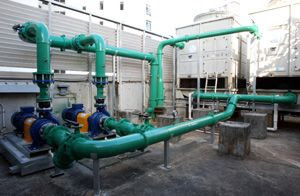Pump Piping
5
BASIC RULES OF PUMP PIPING
Many pumps are
installed with inappropriate piping arrangements, resulting in premature pump
failures as we covered in our latest eBook, 36 Ways to
Kill Your Pump.
If you were
installing a pump in a new system, where would you turn for guidelines on
proper pump piping arrangements?
Knowledge and resources are extremely limited on this topic, except what
you may find in the Installation, Operation and Maintenance (IOM) manual (which
is minimal).
By following 5 simple rules,
you can avoid premature pump failure and related pump piping pitfalls.
1.
KEEP SUCTION
PIPING AS SHORT AS POSSIBLE
 Include a
straight run pipe length equal to 5 to 10 times the pipe diameter between the
pump inlet and any obstruction in the suction line. Note: Obstructions include valves, elbows, "tees", and etc.
Include a
straight run pipe length equal to 5 to 10 times the pipe diameter between the
pump inlet and any obstruction in the suction line. Note: Obstructions include valves, elbows, "tees", and etc.
Keeping the suction piping short ensures that inlet pressure drop is as
low as possible. The straight run pipe gives you a uniform velocity across the
pipe diameter at pump inlet. Both are important to achieving optimal
suction.
2. PIPE DIAMETER ON SUCTION SIDE
SHOULD BE EQUAL OR ONE SIZE LARGER THAN PUMP INLET
Suction piping velocities should be limited to 7 to 8 feet per second or
less.
3. ELIMINATE ELBOWS MOUNTED ON OR
CLOSE TO THE INLET NOZZLE OF THE PUMP
Include 5 to 10 pipe diameters of straight run pipe between the pump
inlet and elbow. This helps to eliminate "side loading" of the
pump impeller and creates uniform pump axial bearing loading.
4. ELIMINATE
POTENTIAL FOR AIR ENTRAPMENT IN THE SUCTION PIPING
o
Maintain adequate levels in supply tanks to eliminate
vortices from forming and air entrapment.
o
Avoid high pockets in suction piping, which can trap
air
o
Keep all pipe and fitting connections tight in
suction vacuum conditions to prevent air from getting into the pump.
5. ENSURE THE
PIPING ARRANGEMENT DOES NOT CAUSE STRAIN ON THE PUMP CASING
Pumps
should never support the suction or discharge piping. Any stress on the pump
casing by the piping system greatly reduces pump life and performance.
Keep in mind that increasing the performance of the
pump will help to make up for piping mistakes made on the discharge side of a
pump.
Problems on the suction side,
however, can be the source of repetitive failures, which could cause
problems for years to come if not addressed appropriately.
Piping design is an area where basic principles are
frequently ignored, resulting in increased vibration and premature failure of the
seals and bearings.
Incorrect piping has long been
disregarded as a reason for these failures because of the many other reasons
this equipment can fail.
Many experienced engineers may
argue that pumps with incorrect piping still function and operate as they
should.
This argument, although valid,
does not make questionable piping practices correct.
**Post adapted from an article
by Ross Mackay, Pitfalls of Pump Piping.
Contact
us today with your questions about correctly installing and piping a
pump! Our engineers are happy to provide assistance to businesses in Wisconsin
and upper Michigan.
Jeff is
an Account Manager at Crane Engineering. For the past 24 years he has
specialized in supply wastewater and process pumping systems for industrial and
municipal clients. He has helped customers with design, project management, and
start-up support for those systems.
RELATED POSTS:
.
.
CLICK HERE . . .
CLICK HERE . . .
CLICK HERE . . .
CLICK HERE . . .
CLICK HERE . . .
CLICK HERE . . .
GS Submersible Pumps
CLICK HERE . . .
 |
Multi-Media Filter, Highly-Activated Carbon Filter,
Zeolite-Process Water Softener With Brine Tank,
Fiberglass Ballast-Type Pressure Tank
(fully automatic backwash & regeneration)
|
PURICARE
Water
Treatment
Systems
.
.
...
Aganan, Pavia, Iloilo, Philippines
...
CLICK HERE . . . to view company profile . . .
CLICK HERE . . . to view company profile . . .















No comments:
Post a Comment